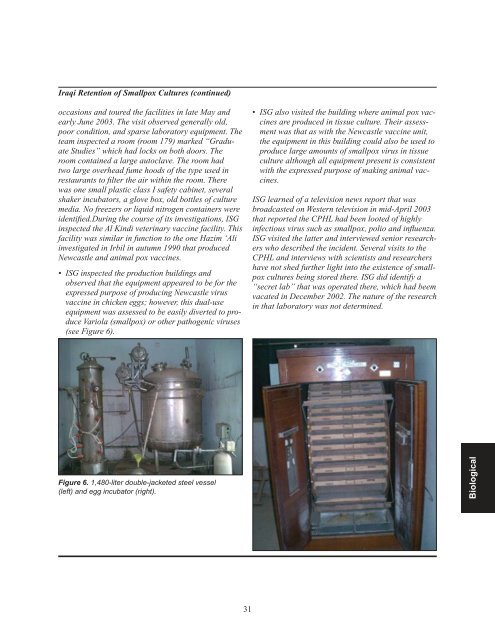Comprehensive Report
GPO-DUELFERREPORT-3
GPO-DUELFERREPORT-3
- No tags were found...
Create successful ePaper yourself
Turn your PDF publications into a flip-book with our unique Google optimized e-Paper software.
Iraqi Retention of Smallpox Cultures (continued)<br />
occasions and toured the facilities in late May and<br />
early June 2003. The visit observed generally old,<br />
poor condition, and sparse laboratory equipment. The<br />
team inspected a room (room 179) marked “Graduate<br />
Studies” which had locks on both doors. The<br />
room contained a large autoclave. The room had<br />
two large overhead fume hoods of the type used in<br />
restaurants to fi lter the air within the room. There<br />
was one small plastic class I safety cabinet, several<br />
shaker incubators, a glove box, old bottles of culture<br />
media. No freezers or liquid nitrogen containers were<br />
identifi ed.During the course of its investigations, ISG<br />
inspected the Al Kindi veterinary vaccine facility. This<br />
facility was similar in function to the one Hazim ‘Ali<br />
investigated in Irbil in autumn 1990 that produced<br />
Newcastle and animal pox vaccines.<br />
• ISG inspected the production buildings and<br />
observed that the equipment appeared to be for the<br />
expressed purpose of producing Newcastle virus<br />
vaccine in chicken eggs; however, this dual-use<br />
equipment was assessed to be easily diverted to produce<br />
Variola (smallpox) or other pathogenic viruses<br />
(see Figure 6).<br />
• ISG also visited the building where animal pox vaccines<br />
are produced in tissue culture. Their assessment<br />
was that as with the Newcastle vaccine unit,<br />
the equipment in this building could also be used to<br />
produce large amounts of smallpox virus in tissue<br />
culture although all equipment present is consistent<br />
with the expressed purpose of making animal vaccines.<br />
ISG learned of a television news report that was<br />
broadcasted on Western television in mid-April 2003<br />
that reported the CPHL had been looted of highly<br />
infectious virus such as smallpox, polio and infl uenza.<br />
ISG visited the latter and interviewed senior researchers<br />
who described the incident. Several visits to the<br />
CPHL and interviews with scientists and researchers<br />
have not shed further light into the existence of smallpox<br />
cultures being stored there. ISG did identify a<br />
“secret lab” that was operated there, which had beem<br />
vacated in December 2002. The nature of the research<br />
in that laboratory was not determined.<br />
Figure 6. 1,480-liter double-jacketed steel vessel<br />
(left) and egg incubator (right).<br />
Biological<br />
31


